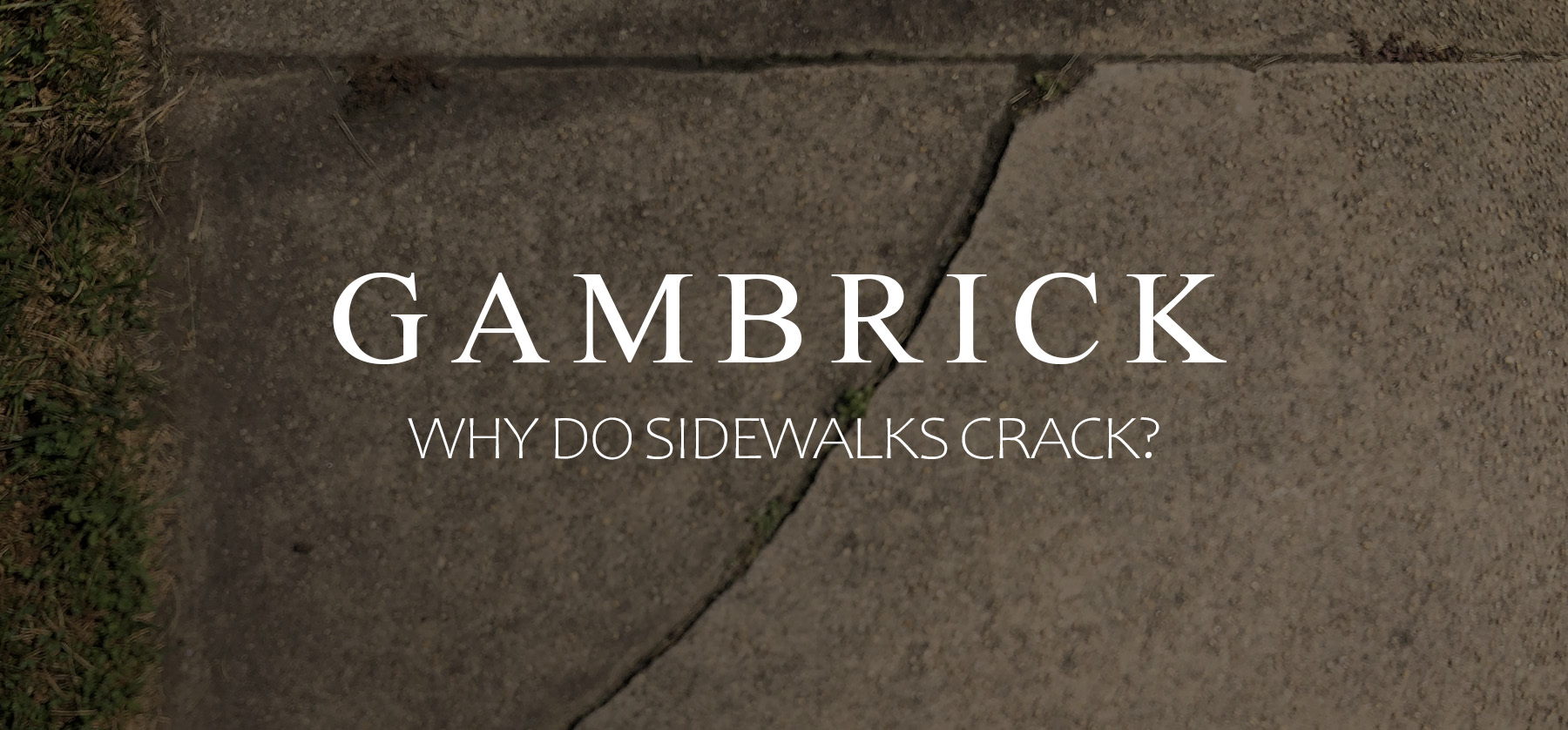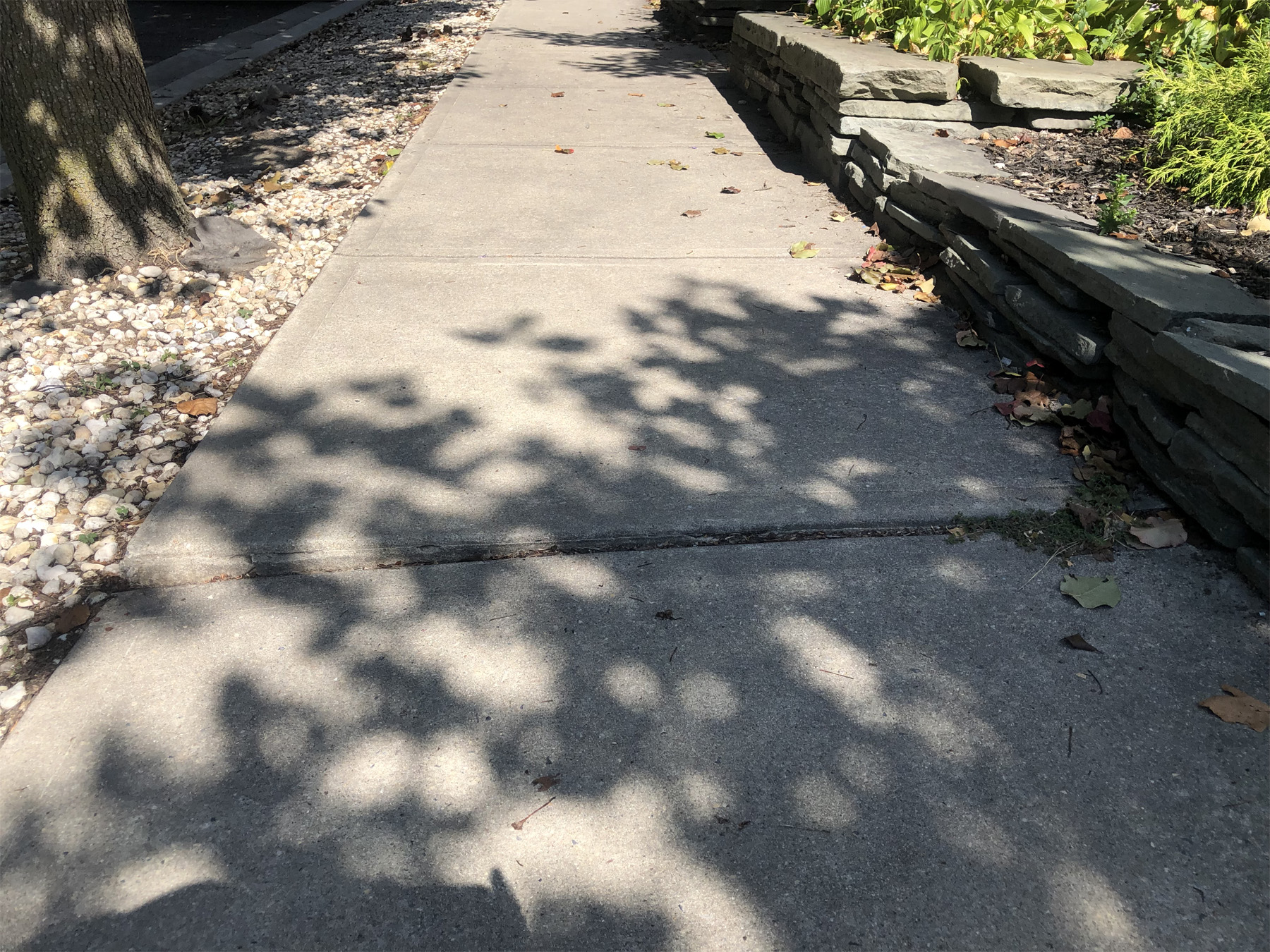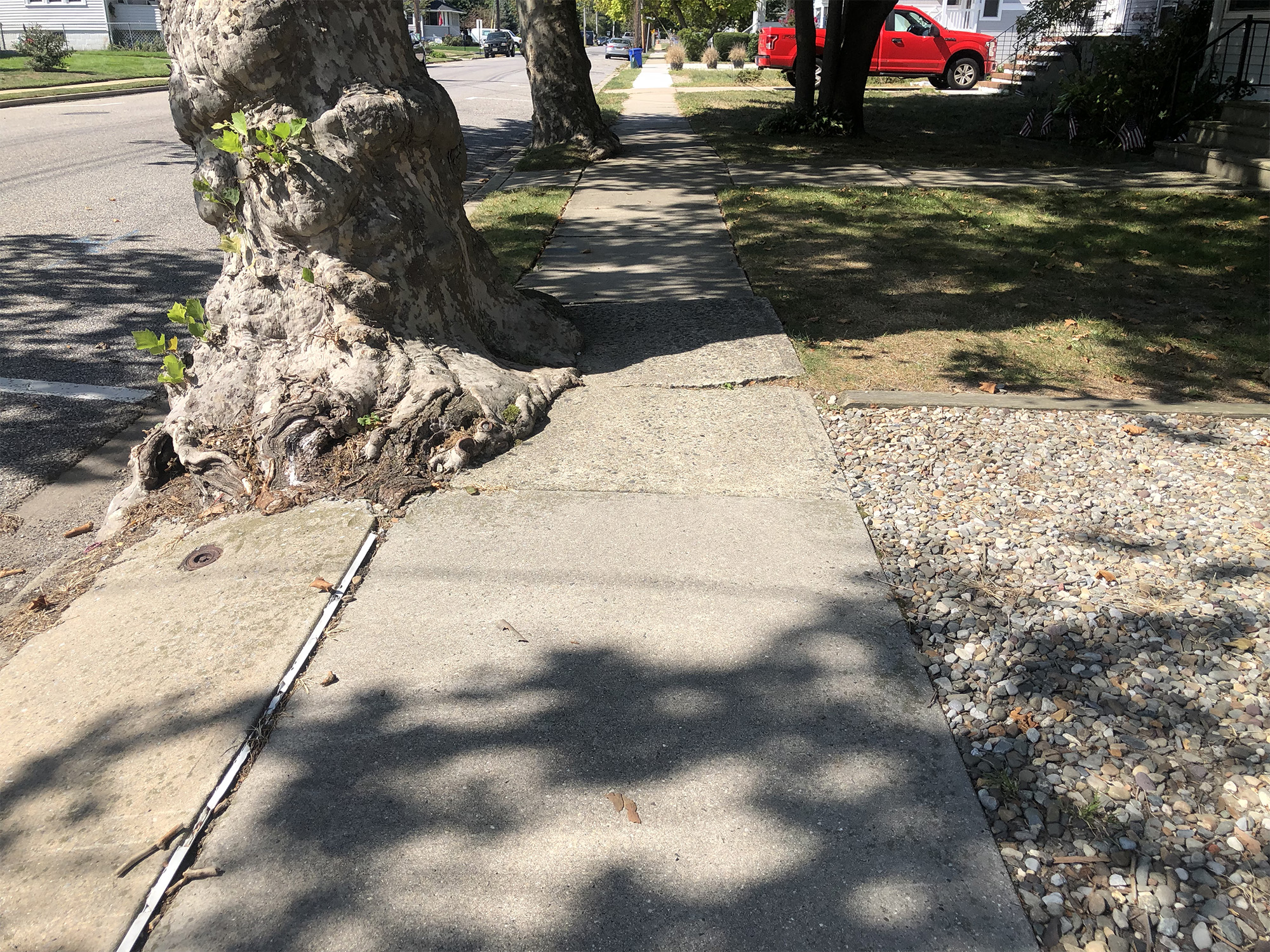Why Do Sidewalks Crack?
Sidewalks crack because of expansion and contraction, uneven settling, soil erosion, roots, impact, poor workmanship, fast drying or bad concrete. There are a lot of reasons why concrete sidewalks crack. Some of them are perfectly normal, like tiny hairline cracks that occur when the concrete dries. But some you should worry about, like medium to large size cracks caused by soil erosion or uneven settling. Sidewalks are strong and durable but can crack from a hard impact. They can also crack from upward pressure caused by roots underneath the slab. This is called a heave. Poor workmanship is also a big reason why sidewalks can crack. This include fast drying and poor quality concrete. If the concrete doesn’t cure properly or there’s too much water in the mix, the sidewalk will be brittle and weak.
Control joints are used to prevent sidewalk cracking. A control joint is a gap between two sections of sidewalk. As the sidewalk expands and contracts or the soil shifts, the concrete needs room to move. Control joints, a.k.a. expansion joint, provide room for the sidewalk sections to move without cracking.
As a rule, a control joint should be installed every 2-3 feet times the thickness of the slab. For example, a 4 inch thick sidewalk should have a control joint every 8-12 feet which is 2-3 times (in feet) the slab’s thickness (4 inch). Control joints can be installed before the concrete is poured or they can be cut into the slab after they’ve set.
While control joints should be used to prevent cracking, they won’t stop them all. Other things should also be done like using the proper base, compaction, reinforcement, drainage, etc.
In this article we’ll review the most common reasons why sidewalks crack and what you can do to prevent them.
What Causes Sidewalks To Crack?
There are a variety of reasons why sidewalks crack. Luckily almost all of them are avoidable if you build the sidewalk properly.
Here’s a list of the most common causes:
- Expansion & Contraction: As the concrete heats up it expands, then it contracts as it cools. This movement builds up pressure inside the concrete. Without a control joint to allow for movement, the concrete can buckle and/or crack.
- Uneven Settling: If the soil beneath the sidewalk settles unevenly, parts of the slab will be unsupported. This can lead to cracking.
- Soil Erosion: Like settling, erosion of the soil beneath a slab creates unsupported areas and possibly cracks.
- Roots: A large root growing in the soil beneath a sidewalk can create upward pressure which can crack the sidewalk and create a heave or high spot.
- Impact: Concrete is strong but it can still crack after a hard impact.
- Poor Workmanship: This can include a number of things like fast drying, bad concrete or too much water. All of which creates weak concrete prone to cracking.
As you can see, there are a lot of reasons why concrete sidewalks can crack. Luckily most are avoidable if you build the sidewalks correctly.
In the next section we’ll break down each cause of sidewalk cracks and tell you how to avoid them.
Expansion & Contraction
One of the most common reasons why concrete sidewalks crack is expansion and contraction stress. As the concrete heats up it expands. Then it contracts as it cools. This movement creates a lot of pressure inside the slab. If the concrete doesn’t have room to move the stress will build up and eventually release by cracking the concrete.
There’s nothing you can do about expansion and contraction stress. All concrete slabs and structures are exposed to it. However you can build a sidewalk in a way that allows for movement.
Control joints, a.k.a. expansion joints, are used to prevent cracks caused by movement.
An expansion joint is a gap between two slabs of concrete. They allow both slabs to move without breaking. Usually the joint is filled with a flexible material that seals the gap so water and materials can’t get in. This can be a fibrous material or a caulk.
Expansion joints can be installed before you pour the concrete or after is set.
- Fibrous strips can be placed inside the slab as concrete is poured to separate two sections of a slab.
- Joints can be cut into the slab after it’s set using a concrete saw.
Using fibrous strips or caulk to seal the control joint helps keep stones from getting into the gap. If a stone falls into the joint, when the concrete expands it will press against the stone. Since stones are harder than concrete, the slab will crack around the stone.
Control joints help with all types of slab movement including settling, erosion and shifting soil.
Uneven Settling
A common reason why sidewalks crack is uneven settling of the soil beneath the slab. When a new concrete sidewalk is poured, the soil is excavated and a base layer of gravel is spread. Both the soil and gravel should be well compacted with a vibratory compactor. If the soil or base isn’t well compacted, it could settle over time.
If all the soil beneath a sidewalk settles at exactly the same rate, the sidewalk will still be evenly supported. However, if it settles unevenly, which is very common, there will be high spots and low spots. This causes areas of the slab to be unsupported.
In areas that don’t have adequate support, the concrete can crack.
The way to prevent cracks caused by uneven settling is by properly compacting both the soil and the gravel base. It’s best to pour a concrete sidewalk on virgin soil so the ground is as hard and compacted as possible. However, on most new homes and developments, the area has been disturbed and graded. This means you have to compact the soil really well or you’ll get some settling.
Pro Tip: Lightly wet the soil and gravel as you compact it. Don’t use too much water or you’ll turn the soil to mud. But a sprinkling of water on top of dirt and stone helps it compact tighter. Compact slowly and over time. When I pour a sidewalk on a new development I typically compact the soil 3-4 times over the coarse of a few days. Between each compaction I wet the soil a bit.
I then repeat the steps with gravel. I typically use 4-6 inches of gravel and compact every 2 inches with some water.
Soil Erosion
A cause of concrete sidewalks cracks are soil erosion. Erosion occurs when water drains beneath a slab carrying soil with it. This is very common after a heavy and sudden rainfall. If the soil beneath a concrete slab erodes away, it leaves behind a void. The void creates an area with unsupported concrete which is prone to cracking.
The way to prevent soil erosion is during the sidewalks preparation. You need a thick and well compacted gravel base which allows water to run through it. When I pour sidewalks in areas that see heavy rainfall, I install my gravel base a little wider than usual and deeper.
In general, I pour my gravel 6 inches deep and 4 inches wider than the sidewalk on either side. However, on both sides of the sidewalk I taper down the gravel so that you don’t see it on the surface.
I also use bigger stones which allow water to flow through them freely.
By using larger gravel and a bigger footing you can help prevent erosion.
The next step is diverting water around the sidewalk. You can do this by installing drainage basins in the yard which lead to the street and by grading the property. I always grade my yards in a way that diverts water away from driveways and sidewalks where possible. Use grading to drive water into the drain basins and out to the sewer.
Finally I pour my concrete extra thick and use reinforcement like rebar or wire mesh. In case some erosion does occur, extra thick, reinforced concrete will be strong enough to support itself over the void.
By properly building your sidewalks and having a plan to deal with rainfall, you can prevent cracks caused by soil erosion.
Roots
Roots are a common cause of sidewalk cracks due to heaving. As a tree root slowly moves away from a tree it also grows thicker. When a root works its way under a sidewalk and then gets thicker, it creates upward pressure. That pressure can break a concrete sidewalk in two causing cracks.
When roots are close to the surface they can completely destroy a concrete sidewalk. They can cause the sidewalk to buckle which forms a large crack.
If the roots are deep you may get some small to medium size cracks.
The damage done by roots growing under your sidewalk depends on their size and how close they are to the surface.
To deal with a cracked sidewalk because of roots you have 4 options:
- Move the sidewalk around the roots
- Raise the sidewalk above the roots
- Remove the root which may also kill the tree
- Redo the sidewalk on top of the root
Repairing a section of sidewalk cracked by roots is hard because you also have to deal with the root. If you simply repair the surface level crack with a patch mix or fresh concrete, the root could continue to grow which will re-crack the concrete.
Avoiding sidewalk cracks by roots is easy, don’t build a sidewalk next to a tree with large roots. Small trees and bushes have small roots which aren’t strong enough to buckle concrete. But large tree roots can easily snap a concrete slab in half.
Do some research on your trees. Some large trees have deep roots and some have shallow roots. Some trees have roots that don’t spread far from the tree while others can spread out for many feet in all directions searching for water. Know your tree before building the sidewalk so you can avoid future cracking.
Impact
Concrete sidewalks can crack due to impact. They’re usually just a 4 inches thick slab which isn’t that hard to crack if you hit it hard enough. Luckily not many things can hit a slab hard enough to cause a crack. But it’s possible during strong storms like hurricanes and tornadoes for large heavy objects to get thrown around causing impact damage.
The severity of an impact crack is very unpredictable. It depends on the weight of the object hitting the slab, where it hits and how hard.
Impact damage can be very minor spider cracks or they can break a slab in half.
Impact cracks are easy to fix because the base and soil beneath the sidewalk isn’t the problem. You won’t have to address roots, settling or erosion issues.
The best way to fix surface cracks are with a filler. The filler you should use depends on the severity of the crack.
Here are your options:
- Liquid Crack Filler: Liquid fillers are a very thin liquid that comes in a bottle with a nozzle tip. Drip some into fine hairline cracks to seal them. These are for tiny cracks only.
- Patch Mix: These are great for medium size cracks. You can buy them in a tub at Home Depot.
- Mortar: Great for medium size cracks. They’re just like a patch mix only you can make mortar yourself by mixing cement, lime and sand with water.
- Concrete: Fresh concrete is for large cracks only. Get a mix that uses small stones.
Clean the crack of all dirt and debris with a bristle brush. Then apply filler as deep into the crack as possible.
If the damage is severe it may be necessary to replace the sidewalk rather than repair it.
Poor Workmanship
Poor workmanship is a common cause of sidewalk cracks. Sidewalks are made from concrete. If the concrete isn’t mixed properly, doesn’t include reinforcement and control joints or the base isn’t well compacted, your sidewalk will be prone to cracking.
Here are some of the most common mistakes that cause sidewalk cracks:
- Over Watering: Using too much water in a concrete mix makes it brittle and easy to crack.
- Under Watering: Too little water leaves dry power inside the mix which is very brittle.
- Bad Mix: Concrete is made by mixing sand, stone and cement with water in a specific ratio to produce 3000 to 4000 psi of compressive strength. If the wrong ratio is used the concrete may be too weak.
- Missing Reinforcement: If the soil is weak or unstable reinforcement like rebar or wire mesh can be used inside the slab to strengthen it.
- Bad Compaction: If the soil or gravel base isn’t well compacted you could get erosion or settling cracks.
- Missing Joints: If the control joints are missing or wrongly spaced you could get expansion and contraction cracks.
- Fast Drying: If the concrete dries too fast you could get spider cracks.
As you can see there are a lot of things that can go wrong when pouring a new sidewalk. Like any other concrete structure, skill and experience play a big role if you want a long lasting sidewalk that won’t crack.
To avoid cracks caused by bad work, hire a professional mason with experience pouring sidewalks. In the construction business we call this specialty flat work.
Why Do Sidewalks Crack In Winter?
Sidewalks crack in Winter when because concrete is a very porous material. When water from rain or snow seeps below the surface,, it can freeze and then expand. This expansion can crack the concrete. However, if freezing water doesn’t create a crack, when the concrete warms it then expands. This can also create a crack. This expansion and contraction over time is called the freeze thaw cycle It can cause cracks, flaking or deterioration of a concrete sidewalk.
Luckily there are a few things you can do to prevent your sidewalks from cracking in Winter.
- Build the sidewalks strong. The best things you can do to prevent cracks in Winter take place when the sidewalks are built.
- Make sure to seal any existing cracks in your sidewalk before Winter. This will keep water out which helps prevent cracks when the water freezes.
There’s not a lot you can do to prevent sidewalk cracks if you live in an area that see cold Winters. The best thing you can do is build them strong so they can resist the freeze thaw cycle.
How To Fix Concrete Sidewalk Cracks
No matter the cause of the sidewalk crack, you have a few options when it comes to making repairs. Repairs involve filling the crack from the base to the surface with new material. These include liquid fillers, a patch mix, mortar or fresh concrete. Which filler works best depends on the size of the crack.
Here’s a list of sidewalk crack repairs and when you should use them:
- Liquid Filler: These fillers are for fine cracks. They’re a very thin liquid that seeps into hairline cracks to fill and seal them.
- Patch Mix: These are for small to medium size cracks. Apply patch material into the crack as deep as possible and level with the surface.
- Mortar: Use mortar just like the patch mix. The difference is that you can make your own mortar by mixing sand, cement and lime with water. Mixing your own repair mortar lets you adjust the strength of the mix a bit.
- Concrete: Use concrete to repair large sidewalk cracks. It’s made by mixing sand, cement and stone with water or buy it in bags. Use concrete between 3000 to 4000 psi for sidewalks.
Before applying filler, use a bristle brush to clean the crack of any dirt or debris.
Before you make repairs to a cracked sidewalk, try to determine the cause. In most cases you should fix the cause before making repairs. If all you do is repair the crack but not it’s cause, the crack will likely come back and get worse.
Is It Normal For Sidewalks To Crack?
It’s normal for some tiny hairline cracks to form on a concrete sidewalk’s surface. Concrete starts off as a semi-solid and then dries. As it dries it shrinks which may cause some tiny hairline cracks on the surface. These small cracks are normal and nothing to worry about. However small, medium and large size cracks are not normal. If a crack opens up that’s wider than a hair, there’s a reason for it.
The most common cause of sidewalk cracks are expansion and contraction. As the concrete heats up it expands. When it cools the concrete shrinks. This movement can crack a sidewalk if it doesn’t have control joints.
Soil erosion and uneven settling are two more very common reasons why sidewalks crack. They’re typically caused when the builder didn’t properly compact the soil or base material below the sidewalk.
Tree roots are another common reason sidewalks crack. When roots grow beneath the sidewalk they create upward pressure that lift and cracks the concrete.
Poor quality workmanship is another reason why concrete cracks. This can include a wide variety of things but is usually a bad concrete mixture with either too much or too little water.
If your sidewalk starts to crack, fix it immediately because most concrete cracks will spread over time. And don;t forget to address the underlying cause of the crack. if all you do is repair the sidewalks surface but don’t fix the underlying cause, he crack will re-form and possibly get worse.
How Do I Keep My Sidewalk From Cracking?
The best way to keep a sidewalk from cracking is during its construction. Once a sidewalk is built there’s very little you can do to prevent cracks. If you want a strong and durable concrete sidewalk that won’t crack, here’s what you need to do.
- Compacted Subgrade: One of the most important things you can do to prevent sidewalk cracks is compacting both the soil and base material below the sidewalk. This is because two of the leading causes of cracks is soil erosion and uneven settling. Both of which can be prevented with a well compacted base.
- Base Material: I use at least 4-6 inches of compacted gravel under a 4 inch thick sidewalk. This provides not only a strong and stable base but also drainage.
- Concrete Mix: Use 3000 to 4000 psi concrete. Make sure it’s properly mixed with the correct amount of water. Too much or too little water both make concrete brittle and prone to cracking.
- Additives: Consider using chemical hardeners or fiber to strengthen the concrete.
- Reinforcement: Use rebar o wire mesh inside the slab to strengthen the sidewalk.
- Thickness: Most concrete sidewalks are 4 inches thick. But you can pour them 5 or 6 inches if you’re worried about cracking. I do this when the soil is poor and/or unstable.
- Joints: Install control joints every 2 to 3 times in feet the thickness of the slab in inches. So a 4 inch thick sidewalk needs a control joint every 8 to 12 feet.
- Curing: make sure you properly cure the concrete. If it dries too fast you could get spider cracks.
There’s not a lot you can do to prevent cracking after the sidewalk is built. So do everything you can before and during its construction to prevent cracks.
Summary: Why Do Sidewalks Crack?
Sidewalks crack because of expansion and contraction, uneven settling, soil erosion, roots, impact, poor workmanship, fast drying or bad concrete. There are a lot of reasons why concrete sidewalks crack. Some of them are perfectly normal, like tiny hairline cracks that occur when the concrete dries. But some you should worry about, like medium to large size cracks caused by soil erosion or uneven settling. Sidewalks are strong and durable but can crack from a hard impact. They can also crack from upward pressure caused by roots underneath the slab. This is called a heave. Poor workmanship is also a big reason why sidewalks can crack. This include fast drying and poor quality concrete. If the concrete doesn’t cure properly or there’s too much water in the mix, the sidewalk will be brittle and weak.
Control joints are used to prevent sidewalk cracking. A control joint is a gap between two sections of sidewalk. As the sidewalk expands and contracts or the soil shifts, the concrete needs room to move. Control joints, a.k.a. expansion joint, provide room for the sidewalk sections to move without cracking.
As a rule, a control joint should be installed every 2-3 feet times the thickness of the slab. For example, a 4 inch thick sidewalk should have a control joint every 8-12 feet which is 2-3 times (in feet) the slab’s thickness (4 inch). Control joints can be installed before the concrete is poured or they can be cut into the slab after they’ve set.
While control joints should be used to prevent cracking, they won’t stop them all. Other things should also be done like using the proper base, compaction, reinforcement, drainage, etc.
If you have any questions or comments about the article email any time.
























